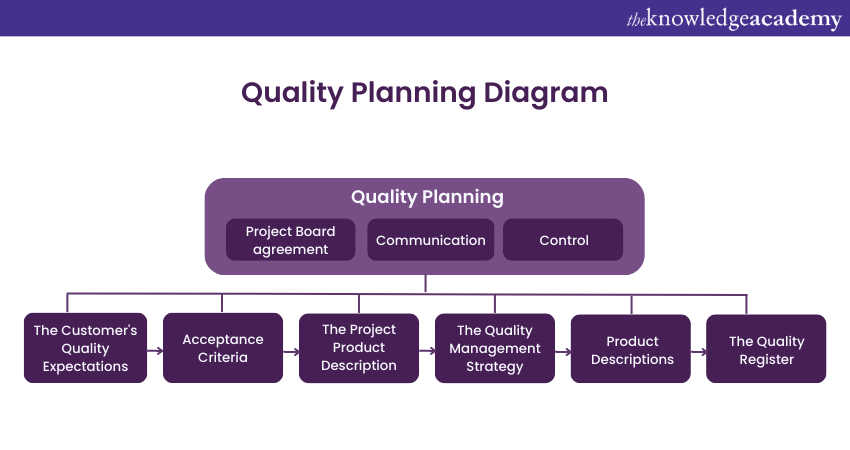We may not have the course you’re looking for. If you enquire or give us a call on 01344203999 and speak to our training experts, we may still be able to help with your training requirements.
Training Outcomes Within Your Budget!
We ensure quality, budget-alignment, and timely delivery by our expert instructors.

The PRINCE2 Quality Theme helps teams achieve and sustain quality at every project stage. Here, quality refers to the standard that the products, team members, and processes involved in a project must achieve to produce the best results. Implementing the quality theme ensures that the project's outcome meets business expectations.
The significance of PRINCE2 is high even today, as Project Management methodologies and software have considerably risen in popularity. According to Mordor Intelligence, the market for Project Management software is estimated to reach up to £7.9 billion by 2026. Learn about the PRINCE2 Quality Theme, how it fulfils requirements, and how you may use the themes of prince2 to manage projects efficiently.
Table of Contents
1) How do you ensure quality in PRINCE2?
a) Quality Management Approach
b) Quality Planning
c) Quality Control
2) Quality Review Technique of PRINCE2
3) Conclusion
How do you Ensure Quality in PRINCE2?
The responsibility of maintaining quality at every stage of a project falls on the Project Manager. They must take note of the customers' expectations regarding product quality and factor that into the product to earn customer satisfaction. Often, customers cannot clearly convey their expectations, leaving the Project Manager to deliver good quality results via effective Quality management.
The factors that change to sustain quality may differ based on the type of organization or project. While some projects prioritise good quality resources, some might focus on the process of creating the product. Quality management can be ensured through steps like quality planning or a quality management approach.
Looking for a high-value certification to upgrade your skillset? Sign up for our PRINCE2® Foundation & Practitioner Training course now!
Quality Management Approach
A quality management approach defines the set of tasks and techniques to help manage product quality. It includes the project's objectives and scope alongside individual responsibilities for certain activities.
It describes the procedure to maintain effective quality management through steps like quality planning, quality control, etc. The approach also includes information about the tools and techniques that can be used to enforce quality in various stages of the project.
Two other features mentioned in the Quality management approach are records and reports that carry the proof of quality management activities being implemented. The timings of the activities are also included. There are particular roles and responsibilities of members that are defined in the approach. They are stated beside the quality criteria set forth by either the customer or corporate.
Quality Planning

Quality planning involves meeting the customers' expectations regarding quality and defining the acceptance criteria of projects. It documents the plans and processes that can help improve product quality, its criteria, and more.
Customer quality expectations are noted at the initial stages of the project. The factors considered at that point are the primary quality requisites and specifications on processes they prefer to apply, among others. Project Managers can review the team's adherence to these factors after every project stage.
The acceptance criteria of a product refer to a set of standards that must be achieved before presenting it to the customer. Appearance, durability, and ease of use are some factors in the acceptance criteria.
The Quality planning stage demands documentation of all the established quality criteria and goals that must be met for customer satisfaction, resulting in the project product description document.
Learn more about the behaviour, concepts, and techniques of Agile through our PRINCE2 Agile® Practitioner course now!
Quality Control
Quality control refers to a couple of steps that the designated people must follow to ensure that the products of a project meet the quality requirements. It is also used to measure the metrics of product quality. The following are some of the steps to be followed for quality control:
a) Quality check: The first step is conducting a product quality check. This entails a detailed review of the product to check if it's meeting the required Quality criteria. Everything from appearance to the product's weight is under rigorous scrutiny.
b) Quality record: After the Quality check, it is imperative to note down your observations. This is done on a Quality record. It carries proof of completing the Quality check through the documentation of your findings.
c) Approval: The next step is to get the steps mentioned above approved. An official sign-off on the product and proof that it has been assessed fairly. The evidence regarding the approval can be stored in a document called an approval record.
Want to improve your knowledge of project management methods like PRINCE2? Sign up for our PRINCE2® Practitioner course now!
Quality Review Technique of PRINCE2
The quality of projects can be reviewed through various methods. The PRINCE2 Quality review technique is a method mentioned in the PRINCE2 manual which can be used for Quality checks. It comprises four roles and three steps. The four roles are:
a) Chair: Organises and coordinates the review meeting
b) Presenter: The presenter is in charge of presenting products and representing producers
c) Reviewer: Checks Quality by comparing it to the originally determined standards and handles improvements
d) Administrator: The administrator helps support the chair
The three steps of the Quality review technique are:
a) Review preparation: The first step of the quality review technique involves the preparation for a product review. The Chair gives the green signal for initiating the review, after which a copy of the product is given to the reviewers with the product description.
The reviewers thoroughly assess the product, who prepare their feedback and hand it back to the Chair. The Chair uses the questions and suggested improvements as the basis for the next meeting with the Presenter.
b) Review meeting: The review meeting starts with the presenter introducing the product and addressing the concerns of the Reviewers, which were stated in the previous meeting.
The Reviewers work together to find solutions, and their deductions are noted in a document by the Administrator. The reviewers propose a collective decision concerning product Quality.
c) Review follow-up: The last stage in the Quality review technique is a follow-up review meeting. The Presenter executes any remaining work, after which the reviewers are given the product again.
If the Reviewers approve the last stretch of work, the product is signed off by the Chair, followed by the Administrator's product approval request. The Quality review results are then shared with stakeholders by the Administrator.
Conclusion
The PRINCE2 Quality Theme is undoubtedly one of the essential Themes of the project management methodology. We hope this blog helped you understand the Quality Theme in PRINCE2, alongside the methods to achieve Quality products.
Frequently Asked Questions
Upcoming Project Management Resources Batches & Dates
Date
 PRINCE2® Foundation & Practitioner Training Course
PRINCE2® Foundation & Practitioner Training Course
Sat 25th May 2024, Sun 26th May 2024
Tue 28th May 2024
Mon 3rd Jun 2024
Sat 8th Jun 2024, Sun 9th Jun 2024
Mon 10th Jun 2024
Mon 17th Jun 2024
Sat 22nd Jun 2024, Sun 23rd Jun 2024
Mon 24th Jun 2024
Mon 1st Jul 2024
Sat 6th Jul 2024, Sun 7th Jul 2024
Mon 8th Jul 2024
Mon 15th Jul 2024
Sat 20th Jul 2024, Sun 21st Jul 2024
Mon 22nd Jul 2024
Mon 29th Jul 2024
Sat 3rd Aug 2024, Sun 4th Aug 2024
Mon 5th Aug 2024
Mon 12th Aug 2024
Sat 17th Aug 2024, Sun 18th Aug 2024
Mon 19th Aug 2024
Tue 27th Aug 2024
Sat 31st Aug 2024, Sun 1st Sep 2024
Mon 2nd Sep 2024
Mon 9th Sep 2024
Sat 14th Sep 2024, Sun 15th Sep 2024
Mon 16th Sep 2024
Mon 23rd Sep 2024
Sat 28th Sep 2024, Sun 29th Sep 2024
Mon 30th Sep 2024
Mon 7th Oct 2024
Sat 12th Oct 2024, Sun 13th Oct 2024
Mon 14th Oct 2024
Mon 21st Oct 2024
Sat 26th Oct 2024, Sun 27th Oct 2024
Mon 28th Oct 2024
Mon 4th Nov 2024
Sat 9th Nov 2024, Sun 10th Nov 2024
Mon 11th Nov 2024
Mon 18th Nov 2024
Sat 23rd Nov 2024, Sun 24th Nov 2024
Mon 25th Nov 2024
Mon 2nd Dec 2024
Sat 7th Dec 2024, Sun 8th Dec 2024
Mon 9th Dec 2024
Mon 16th Dec 2024
Mon 6th Jan 2025
Mon 13th Jan 2025
Mon 20th Jan 2025
Mon 27th Jan 2025
Mon 3rd Feb 2025
Mon 10th Feb 2025
Mon 17th Feb 2025
Mon 24th Feb 2025
Mon 3rd Mar 2025
Mon 10th Mar 2025
Mon 17th Mar 2025
Mon 24th Mar 2025
Mon 31st Mar 2025
Mon 7th Apr 2025
Mon 14th Apr 2025
Tue 22nd Apr 2025
Mon 28th Apr 2025
Tue 6th May 2025
Mon 12th May 2025
Mon 19th May 2025
Tue 27th May 2025
Mon 2nd Jun 2025
Mon 9th Jun 2025
Mon 16th Jun 2025
Mon 23rd Jun 2025
Mon 30th Jun 2025
Mon 7th Jul 2025
Mon 14th Jul 2025
Mon 21st Jul 2025
Mon 28th Jul 2025
Mon 4th Aug 2025
Mon 11th Aug 2025
Mon 18th Aug 2025
Tue 26th Aug 2025
Mon 1st Sep 2025
Mon 8th Sep 2025
Mon 15th Sep 2025
Mon 22nd Sep 2025
Mon 29th Sep 2025
Mon 6th Oct 2025
Mon 13th Oct 2025
Mon 20th Oct 2025
Mon 27th Oct 2025
Mon 3rd Nov 2025
Mon 10th Nov 2025
Mon 17th Nov 2025
Mon 24th Nov 2025
Mon 1st Dec 2025
Mon 8th Dec 2025
Mon 15th Dec 2025







 Top Rated Course
Top Rated Course



 If you wish to make any changes to your course, please
If you wish to make any changes to your course, please


